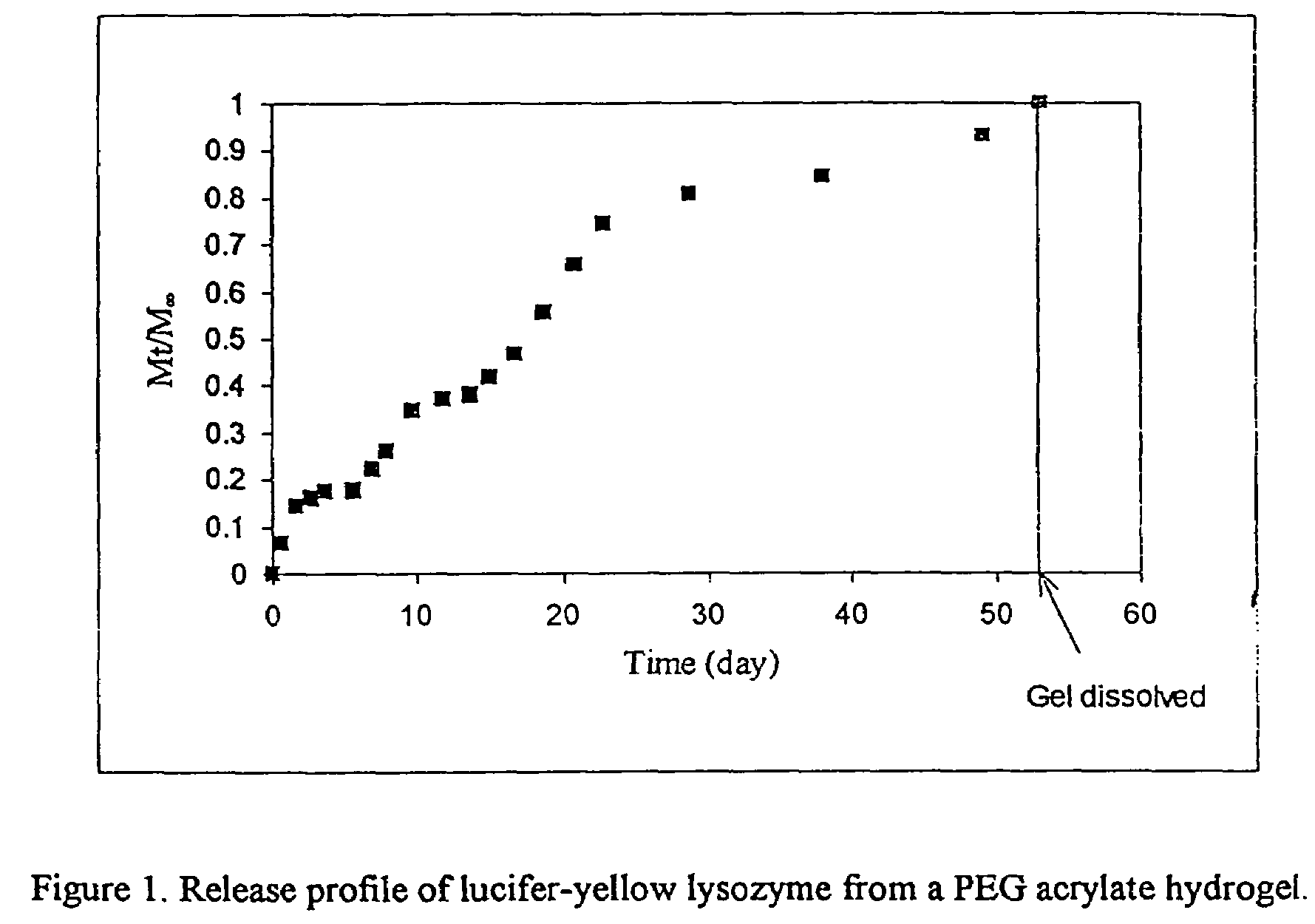Degradable heterobifunctional poly(ethylene glycol) acrylates
a heterofunctional poly and acrylate technology, applied in the field of heterofunctional poly (alkylene oxides), can solve the problems of slow degradation and dissolution of crosslinked gel, reduced the potential for advantageous manipulation of release kinetics, and reduced so as to achieve precise control of release kinetics and reduce the release rate of target hydrogels
- Summary
- Abstract
- Description
- Claims
- Application Information
AI Technical Summary
Benefits of technology
Problems solved by technology
Method used
Image
Examples
example 1
Preparation of CH2═CHCO2-PEG-OCH2CO2CH(CH3)CH2CO2NS
BzO-PEG-OCH2CO2H+SOCl2→BzO-PEG-OCH2COCl+SO2+HCl[0063](Bz=Benzyl)
BzO-PEG-OCH2COCl+HOCH(CH3)CH2CO2H→BzO-PEG-OCH2CO2CH(CH3)CH2CO2H+HCl
BzO-PEG-OCH2CO2CH(CH3)CH2CO2H+H2→HO-PEG-OCH2CO2CH(CH3)CH2CO2H+BzH
HO-PEG-OCH2CO2CH(CH3)CH2CO2H+CH2═CHCOCl+2(CH3CH2)3N→
→CH2═CHCO2-PEG-OCH2CO2CH(CH3)CH2CO2−+2(CH3CH2)3NH++Cl−
CH2═CHCO2-PEG-OCH2CO2CH(CH3)CH2CO2−(CH3CH2)3NH++
a.) Preparation of BzO-PEG-OCH2CO2—CH(CH3)CH2CO2H
[0064]BzO-PEG-OCH2CO2 H (MW=3400, 15 g, 4.4 mmole) was azeotropically dried with 60 ml of toluene under N2. After two hours, the solution was slowly cooled to room temperature. To this solution was added thionyl chloride (18 ml, 36 mmole). The resulting solution was stirred overnight, the solvent condensed by rotary evaporation, and the syrup dried in vacuo for about four hours over P2O5 powder. 3-hydroxybutyric acid (1.45 g, 13.5 mmole) was azeotropically dried with 70 ml of 1,4-dioxane, and then added to the dried BzO-PEG-O...
example 2
Modification of Proteins
a) Modification of Lucifer-yellow Modified Lysozyme
[0070]CH2═CHCO2-PEG-OCH2CO2—CH(CH3)CH2CO2NS (19 mg, 5.5 mmole) was dissolved in 0.1 ml of water and 0.5 ml of lucifer-yellow modified lysozyme solution and (20 mg / ml) in borate buffer (0.1M, pH 8.0) was added. The solution was shaken gently on an auto-shaker at room temperature for 3 hours. Completion of the reaction was demonstrated by capillary electrophoresis. The solution was then stored at 4° C. prior to release studies.
b) Modification of Fluorescein Isothiocyanate-Bovine Serum Albumin (FTIC-BSA):
[0071]CH2═CHCO2-PEG-OCH2CO2—CH(CH3)CH2CO2NS (9.3 mg, 2.7 mmole) was dissolved in 0.5 ml of deionized water and 1.5 ml of FITC-BSA solution (15 mg / ml) in boric buffer (0.1M, pH 8.0) was added. The solution was shaken gently on an auto-shaker at room temperature for 3 hours. Completion of the reaction was demonstrated by capillary electrophoresis. The solution was then stored at 4° C. prior to release studies.
example 3
Preparation of Gels
a.) By Redox Initiation
[0072]A solution of (0.5 ml, 200 mg / ml in water of CH2═CHCO2-PEG-O—CH2CO2CH(CH3)CH2CONH-PEGO2CCH═CH2 or CH2═CHCO2-PEG-O—CH2CO2PEG-O2CCH═CH2, and 0.5 ml of buffered PEG acrylate-modified lucifer yellow lysozyme (Example 2a) solution (10 mg / ml, f and 20 ml of potassium persulfate (K2S2O8, 100 mM) were mixed. To the solution was added 20 ml of iron sulfate (FeSO4, 100 mM). After rapid shaking, a gel formed in a few minutes.
[0073]A suitable buffer for this procedure is boric buffer (0.1 M) or phosphate buffer (<0.01M) with pH range of 6 to 8.
b.) By Photo Initiation
Difunctional PEG Acrylate Solution (0.5 ml, 400 mg / ml in water, CH2═CHCO2-PEG-O CH2CO2CH(CH3)CH2CONH-PEGO2CCH═CH2 or CH2═CHCO2-PEG-O—CH2CO2PEG
[0074]—O2CCH═CH2, 0.5 ml of buffered (pH 7) PEG acrylate-modified FTIC-BSA solution (Example 2b) and 100 ml of 2,2-dimethoxy-2-phenyl-acetophone solution (10 mg / ml in ethanol) were mixed. The solution was exposed to UV radiation at a wavelength o...
PUM
 Login to View More
Login to View More Abstract
Description
Claims
Application Information
 Login to View More
Login to View More - R&D
- Intellectual Property
- Life Sciences
- Materials
- Tech Scout
- Unparalleled Data Quality
- Higher Quality Content
- 60% Fewer Hallucinations
Browse by: Latest US Patents, China's latest patents, Technical Efficacy Thesaurus, Application Domain, Technology Topic, Popular Technical Reports.
© 2025 PatSnap. All rights reserved.Legal|Privacy policy|Modern Slavery Act Transparency Statement|Sitemap|About US| Contact US: help@patsnap.com


